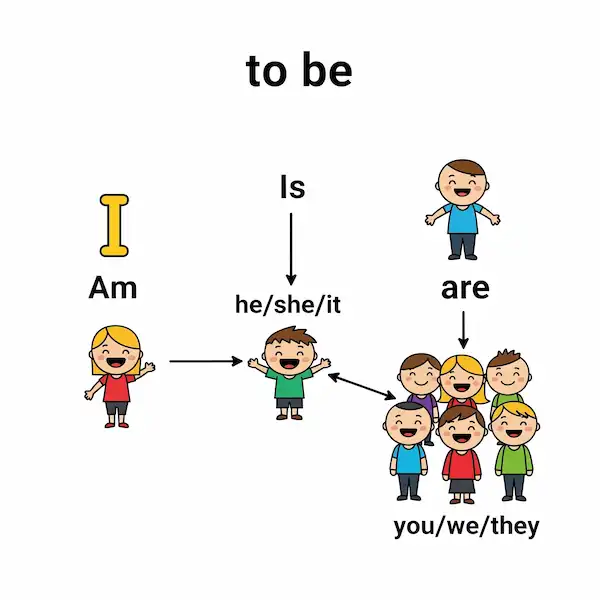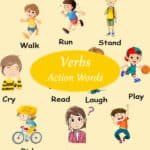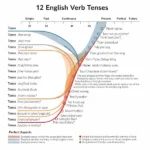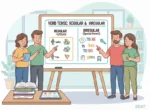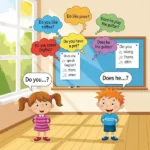The Verb ‘To Be’: Your First and Most Important English Verb
You’re about to embark on an exciting journey learning English! And the very first, most crucial step is understanding the verb ‘to be’. Think of it as the foundation of your English house – without it, everything else will be wobbly.
This article is designed especially for you, a beginner English student, with lots of examples to make everything clear. We’ll also include some extra helpful tips and links to other great resources.
The verb “to be” is like a chameleon; it changes its form depending on who or what you’re talking about and when it’s happening. But don’t worry, once you get the hang of its different forms, you’ll use it all the time!
What does the verb ‘to be’ mean?
“To be” is used for many things, but its core meaning is about existence, identity, and state. It tells us what something is, who someone is, or how something is.
The Present Tense Forms of verb ‘to be’
Let’s start with the present tense, which is used for things happening now, or for facts that are always true.
Here are the three main forms of “to be” in the present tense:
- am (used with “I”)
- is (used with “he,” “she,” “it,” and singular nouns)
- are (used with “you,” “we,” “they,” and plural nouns)
Let’s look at some examples:
1. “I am…” (Identity/State)
This is how you talk about yourself!
- I am a student. (Identity)
- I am happy. (State/Feeling)
- I am from Cambodia. (Origin)
- I am 25 years old. (Age)
2. “He is / She is / It is…” (Identity/State for Singular)
Use “is” for one person or one thing.
- He is my brother. (Identity)
- She is tall. (Description)
- It is a cat. (Identity)
- The book is on the table. (Location – “The book” is singular)
- My phone is new. (Description – “My phone” is singular)
3. “You are / We are / They are…” (Identity/State for Plural and “You”)
“Are” is used for more than one person or thing, and also for “you” (whether you’re talking to one person or many).
- You are kind. (Description – talking to one person)
- You are good friends. (Description – talking to many people)
- We are learning English. (Activity)
- They are in the park. (Location)
- The children are playing. (Activity – “The children” is plural)
- My parents are doctors. (Identity – “My parents” is plural)
Contractions: Speaking More Naturally
In everyday English, we often shorten “to be” forms with pronouns. These are called contractions, and they make your English sound more natural!
- I am = I’m
- I’m hungry.
- He is = He’s
- He’s a good teacher.
- She is = She’s
- She’s beautiful.
- It is = It’s
- It’s raining.
- You are = You’re
- You’re very smart.
- We are = We’re
- We’re ready.
- They are = They’re
- They’re outside.
Negative Sentences with the verb ‘to be’
Making a sentence negative with “to be” is super easy! Just add “not” after the “to be” verb.
- I am not a doctor. (or I’m not a doctor.)
- He is not tall. (or He isn’t tall.)
- She is not happy. (or She isn’t happy.)
- It is not cold. (or It isn’t cold.)
- You are not sad. (or You aren’t sad.)
- We are not finished. (or We aren’t finished.)
- They are not home. (or They aren’t home.)
Yes/No Questions with the verb ‘to be’
To ask a yes/no question with “to be,” simply switch the order of the “to be” verb and the subject.
- Am I late? (Yes, you are. / No, you aren’t.)
- Is he from China? (Yes, he is. / No, he isn’t.)
- Is she your sister? (Yes, she is. / No, she isn’t.)
- Is it a sunny day? (Yes, it is. / No, it isn’t.)
- Are you tired? (Yes, I am. / No, I’m not.)
- Are we going? (Yes, we are. / No, we aren’t.)
- Are they students? (Yes, they are. / No, they aren’t.)
Additional Helpful Content for Your Learning Journey
- Practice, Practice, Practice!
- Say it aloud: Repeat the examples. Make up your own sentences.
- Write it down: Write sentences using “I am,” “He is,” “They are,” etc.
- Listen actively: Pay attention to how native speakers use “to be” in movies, songs, and conversations.
- Label things: Point to objects around you and say “It is a chair,” “It is a table,” etc.
- Describe people: Look at pictures and describe people: “He is happy,” “She is young,” “They are friends.”
- Don’t Confuse “To Be” with Other Verbs: “To be” describes a state or identity. It’s different from action verbs like “run,” “eat,” or “sleep.”
- Correct: I am a student. (State/Identity)
- Incorrect: I am run. (You wouldn’t say this!)
- Correct: I run every day. (Action)
- Start a Simple English Notebook: Dedicate a notebook just for English. Write down new vocabulary, grammar rules, and especially examples of “to be” sentences.
- Find a Language Partner (if possible): Practicing with someone else, even another beginner, can be incredibly helpful and fun! You can take turns making sentences with “to be.”
Practice make perfect
Here is a PDF worksheet you can download with 25 sentences for practicing using the verb “To Be”. The answers are on a separate sheet.
Additional Helpful Information
More about verbs – What are Verbs? How to use Verbs When Speaking English?
Study the 12 tenses of verbs – 12 English Verb Tenses: The Ultimate Guide with Examples
Information about the English Prepositions of Place – Learn English Prepositions of Place – ‘In,’ ‘On,’ and ‘At’
External Links for Authoritative Sources
Here are some excellent and trustworthy resources where you can find more information and practice exercises on the verb “to be”:
- British Council LearnEnglish – The Verb ‘To Be’: A well-respected organization offering clear explanations and exercises.
- Cambridge Dictionary – Grammar (Verb “Be”): A comprehensive and reliable dictionary with grammar explanations.
- EnglishClub – Verb To Be: Offers a good overview with plenty of examples.
By mastering “to be,” you’re building a strong foundation for all your future English learning. Keep practicing, stay curious, and you’ll be speaking English confidently in no time! Good luck on your journey!
